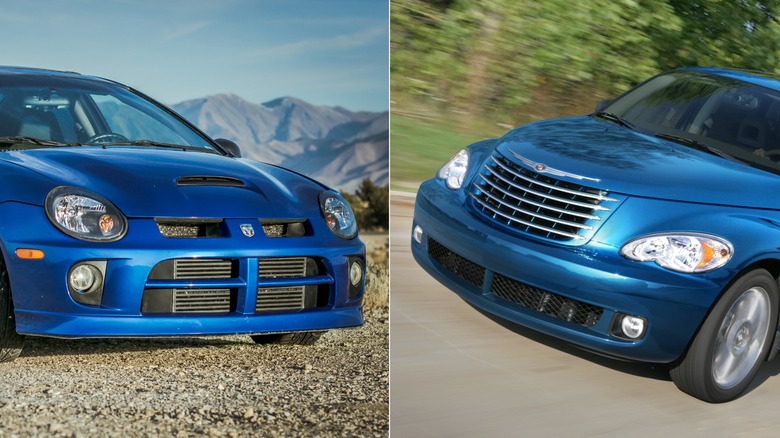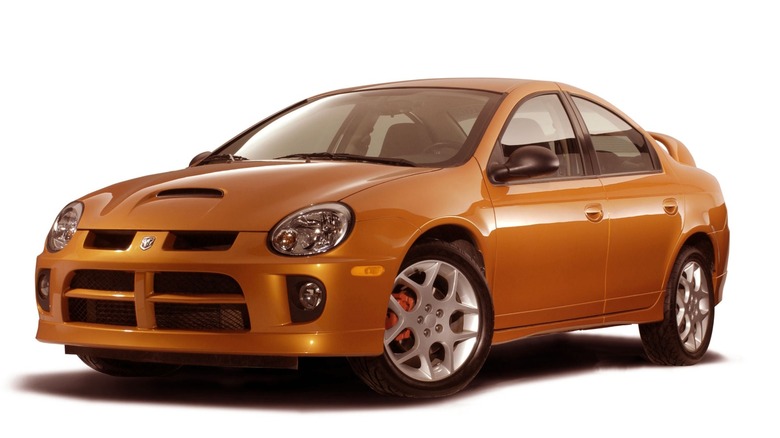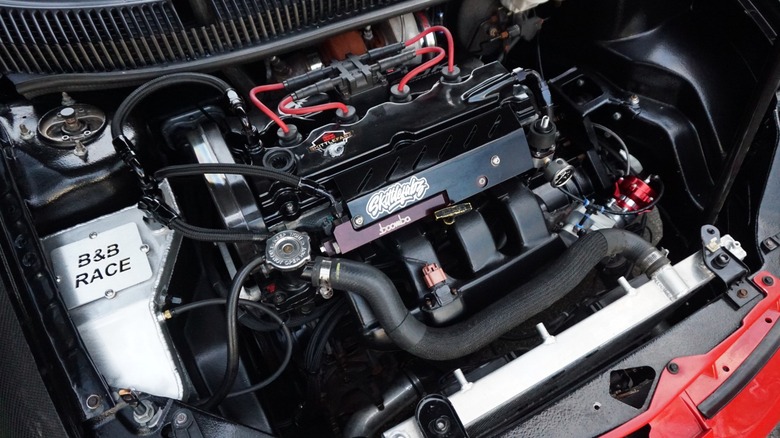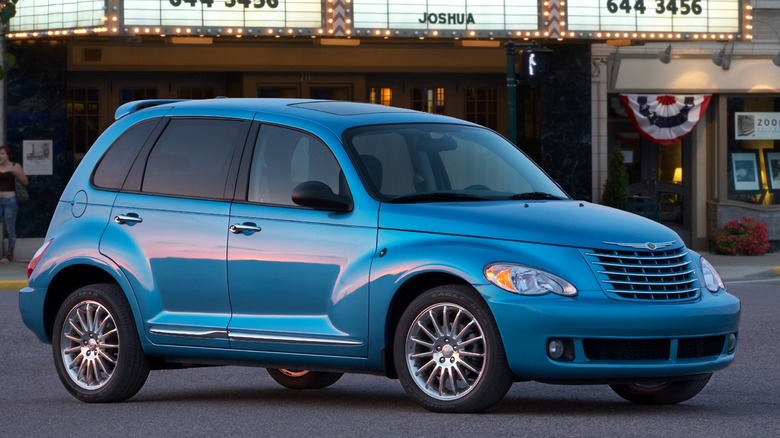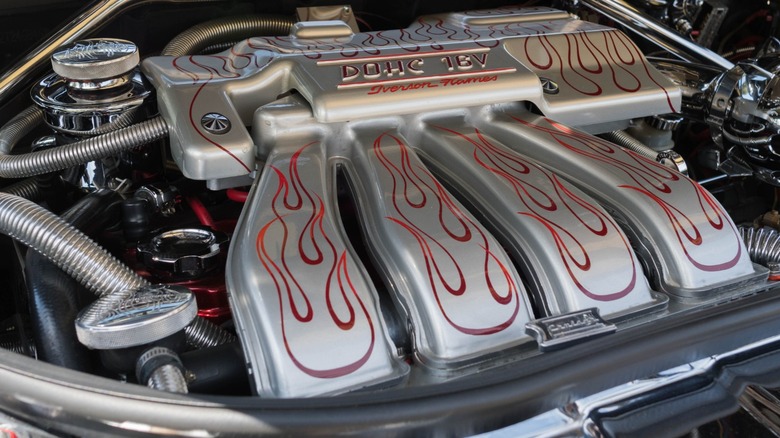How Much HP Did The Dodge Neon SRT-4 Have & Is The PT Cruiser Turbo Actually Faster?
The Dodge Neon and the PT Cruiser are some of the most polarizing models that Chrysler ever made, and they're often ranked among the most hated cars in the world. To many, the Dodge Neon is nothing but a boring, compact econobox. And, while the PT Cruiser was a great success, taking advantage of the retro wave of the 2000s and selling over a million units throughout its run, it didn't have many young buyers, thus giving it the reputation that it was a car for old people.
Nevertheless, both vehicle models have their cult following and communities, so if you do fall in love with one of these car models, you'll find yourself in good hands. It's for this reason that the Dodge Neon and the PT Cruiser are both great used cars to get into. However, the base versions of these models aren't exactly sports cars, so don't expect to go fast with either of them.
But if you really like the personality of these car models and want to have a bit of speed and driving excitement, then you're in luck. That's because the Dodge Neon and PT Cruiser both had variants that featured more powerful engines — the Dodge Neon SRT-4 and the Chrysler PT Cruiser GT. So how much horsepower did these two vehicles have and which of them is actually faster?
What is the Dodge Neon SRT-4?
The Dodge Neon was designed to bring you from point A to point B in the most economical way possible. But after Chrysler's performance division, the SRT, had its way with the Neon, the compact sedan turned into a performance monster with the Dodge Neon SRT-4. Some might think that Chrysler took the easy way out by just plunking in a huge motor to replace the base Neon's 2.0-liter naturally aspirated motor, but the team behind it did way more than that.
Yes, the Neon SRT-4 did receive a bigger 2.4-liter engine, with turbocharging to boot, but the specialists the SRT also gave it a New Venture Gear T-850 5-speed manual transmission mated to a Sachs performance clutch, delivering power to its 17x6 cast aluminum wheels shod in 205/50 R17 Michelin Pilot Sport tires. And to help you throw the car about on the track or in the twisties, MotorTrend said the performance variant received "bigger front and rear anti-roll bars, updated knuckles, a unique k-member, firmer springs, and upgraded SRT-specific struts for improved handling." It also got upgraded front and rear disc brakes, measuring 11 inches and 10.6 inches in diameter, respectively.
Although the Dodge Neon SRT-4 is not as legendary as the BMW M3 or Acura Integra Type-R, it was Chrysler's response to affordable yet fast compact sedans like the Honda Civic Si or the BMW 330i. That's why it's among our list of cheap cars that will over 155 mph.
How much HP did the Dodge Neon have?
Given all those changes, one question remains: How much horsepower does the Dodge Neon SRT-4 deliver? According to Automobile Catalog, the turbocharged engine under its hood could deliver 230 hp and 250 ft.-lb. of torque — about 100 horses and 120 ft.-lbs. of torque more than the naturally aspirated two-liter engine found in the vanilla Dodge Neon. This translates to a 5.9-second 0 to 60 mph record and a top speed of 150 mph, which is already quite a record for its time.
These numbers are actually better than the records of the 2003 Honda Civic Si, which had an 8.3-second 0 to 60 mph record and a top speed of just 133 mph, and it even defeated the 2001 Acura Integra Type-R, with its 6.8-second 0 to 60 mph time and 149 mph top speed. Even the 2001 BMW 330i only hit 6.2 seconds for its 0 to 60 mph time, although its top speed is 5 mph higher. The only car that it couldn't theoretically beat is the 2001 BMW M3, with its 4.4-second 0 to 60 mph time and 176 mph top speed.
What is the PT Cruiser Turbo?
Although the PT Cruiser is one of the strangest cars made in the 2000s, it was still a popular and well-loved car throughout its model run. It's just unfortunate that most of its buyers are from the older demographic, thus giving it the reputation of being a car that senior citizens loved. But even so, Chrysler still made a more powerful version of this rather quirky car and called it the PT Cruiser GT.
The PT Cruiser GT had the same turbocharged 2.4-liter inline-4 engine from the Neon SRT-4, but it's available with either a four-speed automatic or five-speed manual transmission (unlike the Neon SRT-4, which only came with a manual). It also received stiffer springs and firmer dampers, as well as disc brakes on all four corners with ABS for better safety with the additional power. All this is kept on the road by 17-inch aluminum wheels wrapped in 205/50H R17 Goodyear Eagle RSA all-season performance tires, allowing you to get the most out of this retro-styled hot rod.
How much power did the PT Cruiser had under the hood?
The PT Cruiser GT, with its turbocharged engine, produced 230 hp and 245 ft.-lbs. of torque. This is a big upgrade over the output of the naturally aspirated engine in the vanilla PT Cruiser, which only put out 141 hp and 158 ft.-lbs. of torque. Nevertheless, we already expected those numbers for the PT Cruiser GT, especially as it's the same engine found on the Dodge Neon SRT-4. However, the former is much heavier, weighing 3,329 pounds (versus the Neon SRT-4's 2,899 pounds), giving it a 430-pound disadvantage.
Because of this, the PT Cruiser GT is more than a second slower to hit 60 mph from a complete stop, getting a 7-second 0 to 60 record. It also has a lower top speed of just 138 mph, which isn't helped by its boxier shape that offers a higher drag coefficient versus the sleeker Neon SRT-4. Nevertheless, this is still a much better number compared to many of its contemporaries in the early 2000s. And if you face off with a 2001 Honda Civic Si, you could easily hand it its defeat if you have this turbocharged wagon.
The Dodge Neon SRT-4 is still faster than the PT Cruiser Turbo
So, given all those numbers, it's apparent that the Dodge Neon SRT-4 is still faster than the PT Cruiser Turbo by more than a full second, and it could also hit a higher top speed. This just makes sense, especially as the former is a sporty, compact car designed to go head-to-head with other performance vehicles.
Nevertheless, even if the Neon SRT-4 has more speed and performance than PT Cruiser GT, it doesn't mean that it's the better car. After all, the latter offers more personality and quirkiness, while simultaneously ensuring that you still have a little bit of speed. Besides, the roomy interior and practicality of the PT Cruiser should be more than enough to make up for its relative sluggishness versus the Neon SRT-4. Aside from that, Chrysler hasn't made anything similar ever since it discontinued the PT Cruiser, ensuring you'll own something unique.
In the end, don't let these numbers dictate whether you're going for the sporty compact or the quirky wagon. Instead, choose a ride where you'll have fun the most — whether it be through raw speed and power or through the fun and quirky community. After all, smiles per hour is more important than miles per hour.
